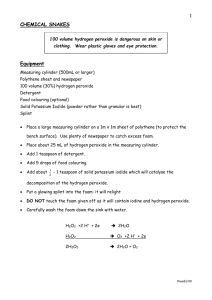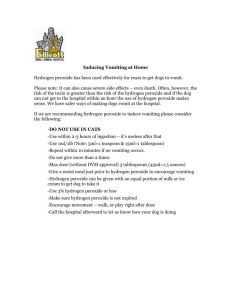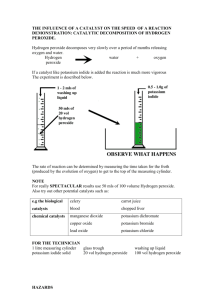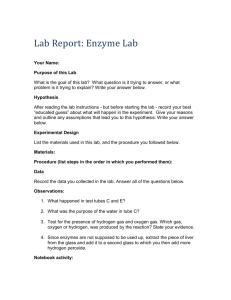17. Hydrogen peroxide 1. Food Teachers’ guide 71
advertisement
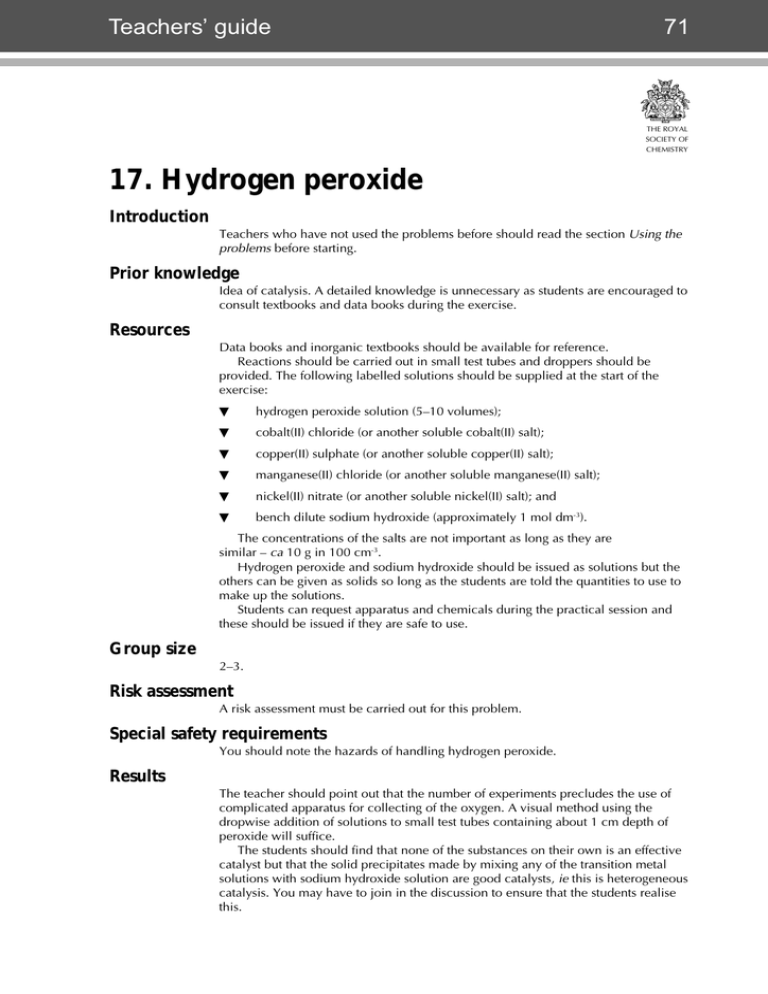
1. Food Teachers’ guide 71 71 THE ROYAL SOCIETY OF CHEMISTRY 17. Hydrogen peroxide Introduction Teachers who have not used the problems before should read the section Using the problems before starting. Prior knowledge Idea of catalysis. A detailed knowledge is unnecessary as students are encouraged to consult textbooks and data books during the exercise. Resources Data books and inorganic textbooks should be available for reference. Reactions should be carried out in small test tubes and droppers should be provided. The following labelled solutions should be supplied at the start of the exercise: ▼ hydrogen peroxide solution (5–10 volumes); ▼ cobalt(II) chloride (or another soluble cobalt(II) salt); ▼ copper(II) sulphate (or another soluble copper(II) salt); ▼ manganese(II) chloride (or another soluble manganese(II) salt); ▼ nickel(II) nitrate (or another soluble nickel(II) salt); and ▼ bench dilute sodium hydroxide (approximately 1 mol dm-3). The concentrations of the salts are not important as long as they are similar – ca 10 g in 100 cm-3. Hydrogen peroxide and sodium hydroxide should be issued as solutions but the others can be given as solids so long as the students are told the quantities to use to make up the solutions. Students can request apparatus and chemicals during the practical session and these should be issued if they are safe to use. Group size 2–3. Risk assessment A risk assessment must be carried out for this problem. Special safety requirements You should note the hazards of handling hydrogen peroxide. Results The teacher should point out that the number of experiments precludes the use of complicated apparatus for collecting of the oxygen. A visual method using the dropwise addition of solutions to small test tubes containing about 1 cm depth of peroxide will suffice. The students should find that none of the substances on their own is an effective catalyst but that the solid precipitates made by mixing any of the transition metal solutions with sodium hydroxide solution are good catalysts, ie this is heterogeneous catalysis. You may have to join in the discussion to ensure that the students realise this. 72 Creative Problem Solving in Chemistry THE ROYAL SOCIETY OF CHEMISTRY Suggested approach During trialling the following instructions were given to students and proved to be extremely effective: 1. Working as a group, decide how you are going to carry out the practical work. You should divide the experiments amongst yourselves and keep each other informed of progress. Such discussion plays an important part when organising experimental methods. Start with as simple a method as possible, and refine it if necessary. 2. Write up in note form what you plan to do. 3. Get your method checked for safety and then carry out the practical work. 4. Write a brief account of what you did. You should include any problems may have been encountered. 5. As a group, discuss your results, looking particularly for any patterns. 6. Working as a group, prepare a short (ca 5-minute maximum) presentation to give to the rest of the class. If possible all group members should take part: any method of presentation (such as a blackboard, overhead projector, etc) can be used. Outline the problem, describe what you did and explain your conclusion. After the presentation, be prepared to accept and answer questions and to discuss what you did with the rest of the class. Background information School Science Review, 1978, 59, 501. The effectiveness of some of the first row transition elements is investigated quantitatively. 1. Food The problems 17 17 THE ROYAL SOCIETY OF CHEMISTRY 17. Hydrogen peroxide From the solutions provided, find the best catalyst for the decomposition of hydrogen peroxide. The solutions should be tested singly and in pairs to investigate whether solutions or solids are the best catalysts. Hydrogen peroxide decomposes into water and oxygen gas: 2H2O2(aq) → 2H2O(l) + O2(g) This is a slow reaction but is catalysed by a variety of different substances. You should refer to any sources of information that you think might help such as your notebooks, textbooks and data books. Ask for assistance if you get stuck. Safety Normal safety procedures when handling chemicals should be adhered to and eye protection worn. Note that hydrogen peroxide is corrosive and a powerful oxidising agent; if any gets spilled, deal with the spill immediately. You must get your method checked for safety before starting on the practical work.



